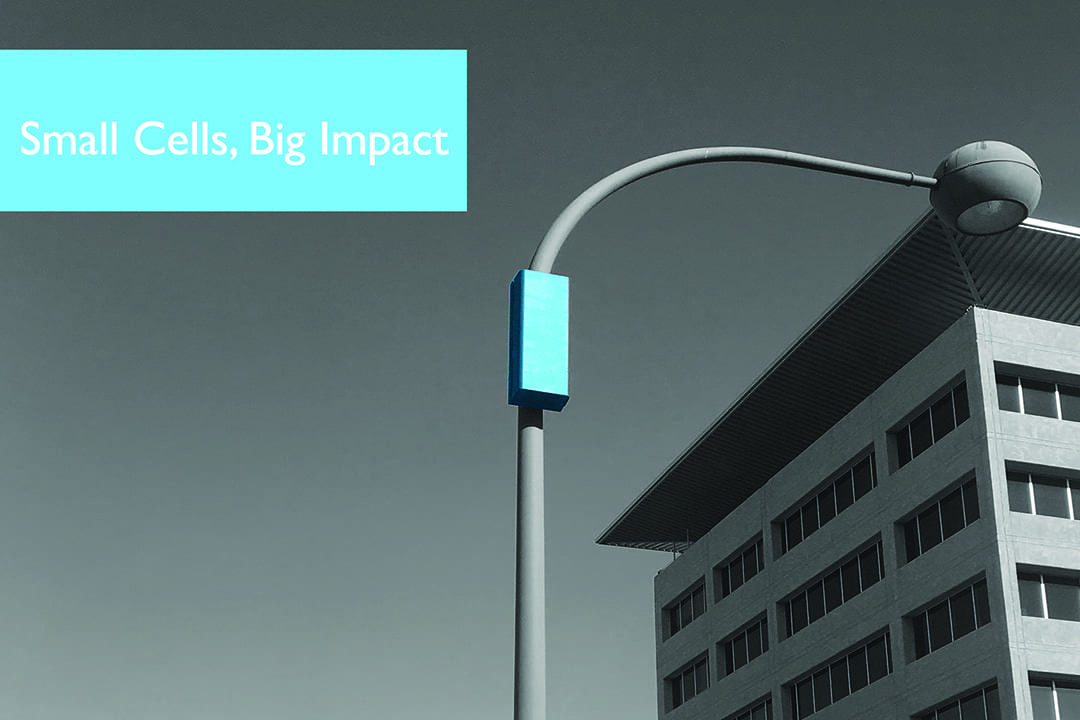Small Cells, Big Impact

In today’s wireless society, the use of small cells has become prevalent as users demand better and faster networks. And it’s easy to understand why. Small cells deliver cost-effective network coverage in an aesthetically pleasing design. Most users are unaware of the cells stationed strategically around their cities. The age of small cells comes at a time where reliability and speed are everything to the end-user.
What are Small Cells
Small cells are wireless access points which include a small form factor antenna, radio head, and base station. They increase capacity and coverage in areas with high user quantities, such as sports venues, colleges, and shopping malls. These small, weather proof, nodes are generally placed on street lights and signs in the right-of-way (ROW). Comparatively, a macrocell or macrosite is a cell in a cell phone network that provides coverage served by a high-power cell site.
Recently network giants, such as Verizon and T-Mobile have been rolling out small cells across the country to support their ‘Unlimited Data’ campaigns. Currently, 2.3 billion people use a smart device which offers numerous things including easier access to social media platforms, and data consuming applications.
In 2015, when the Kansas City Royals won the World Series more than 800,000 people migrated to downtown Kansas City. The large quantity of Royal’s fans in a dense area caused phone calls to drop, text messages to fail, and tweets to stall. Wireless carriers such as AT&T, Sprint and Verizon optimized cell sitesalong the route of the parade to handle the unexpected massive increase in traffic. Verizon deployed two temporary small cell sites to support fans as they celebrated the win.
However, when wireless networks have time to prepare for situations of large user quantities they can potentially spend up to $25 million dollars upgrading their network. In 2016, the Pope visited Washington D.C., New York City, and Philadelphia. Verizon invested $24 million dollars over 18 months, to boost capacity in downtown Philly. AT&T spent more than $25 million quadrupling their mobile network, which included the installation of over 200 small cell sites.
The future of Small Cells
What should we expect from small cell development over the next few years? For one, the increase in the deployment of small cells by all wireless carriers. Currently, society is on the verge of 5G. What 5G will specifically be comprised of is still uncertain. We do know, however, that when deployed, 5G will revolutionize the Internet of Things (IoT). The way we work, live, and play will be radically change with this new standard. Recently, the Federal Communications Commission (FCC) approved policies to stream line the small cell approval process in preparation for 5G.
Small Cells + Smart Cities
The implementation of small cells today will aid in the development of a smart city infrastructure for tomorrow. Smart Cities use information and technology to create a more efficient and sustainable environment for people who work and live in the city. But what makes a city smart? Livability, workability, sustainability, and mobility are the core values behind a smart city. Today, more than half of the world’s population resides in an urban area, and that number is on the rise. Smart cities will allow new technologies to connect not only people, but objects and communities as well.
Kansas City is in the unique position to fully experience the 5G revolution. Recently two wireless giants, Sprint and T-Mobile declared their intent to merge. Sprint, who has a huge presence in Kansas City with their headquarters located in Overland Park, Kansas, has rolled out small cells around town. The companies’ combined can compete with Verizon and AT&T on a 5G buildout which they could not do otherwise. Currently, Kansas City, Missouri (KCMO) has a request for proposal (RFP) out for solicitation focusing on a smart city infrastructure.
Small Cells + Autonomous Vehicles
As the hype behind autonomous cars grows it’s important to realize that in order to make self-driving cars a reality for the masses, 5G will have to be implemented. Autonomous vehicles will rely upon 5G to operate, as well as, communicate with passengers and other self-driving cars to prevent collisions. Small cells located in intersections and/or other places of high user frequency will allow the vehicle to update its surroundings in real time allowing for safer trips.
Aspects of smart cities such as smart stop lights and cameras will be able to monitor surroundings for hazards, such as a pedestrian crossing, and then communicate with the vehicle creating a safer environment. Networks will need small cells to ensure the speed and reliability of the network are consistent and can meet the demands of the smart cities/autonomous vehicles.
Even though the use of small cells provides countless benefits, firms still face issues with implementation. Deployment challenges, permitting, easement issues, and zoning requirements can take time depending on the city. Municipalities have voiced concerns over aesthetics, noise, and right-of-way issues. With any new technology the uncertain future can be a reason to proceed with caution. Here at BHC RHODES, we work to ensure a successful deployment for both the wireless carrier and the local government. Understanding the needs of the customer and municipalities from project conception to close-out allows BHC RHODES to provide the best quality service.
Luckily, small cells provide a larger sum of benefits to the consumer. Dropped calls, messages that failed to send, and high data charges may become a problem of the past. Small cells create a secure, reliable, and personal network signal that minimize disturbances to the consumer. One thing is clear; the race to 5G has taken off.
